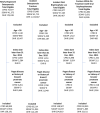One- and 2-year incidence of osteoporotic fracture: a multi-cohort observational study using routinely collected real-world data
- PMID: 34392386
- PMCID: PMC8758600
- DOI: 10.1007/s00198-021-06077-0
One- and 2-year incidence of osteoporotic fracture: a multi-cohort observational study using routinely collected real-world data
Abstract
We estimated and characterized the imminent fracture risk (1-2 years) of high-risk fracture patients through a multinational (UK, Spain, Denmark) cohort study. Older individuals with newly diagnosed osteoporosis and individuals who had a fracture while on treatment with a bisphosphonate were at a high risk of imminent fracture.
Purpose: To characterize and estimate 1- to 2-year fracture risk in high-risk fracture patients.
Methods: Multi-cohort study in (database/study period) UK (CPRD/1995-2017), Spain (SIDIAP/2006-2016) and Denmark (DHR/1995-2016) including individuals ≥ 50 years old in NDO (newly diagnosed osteoporosis), OFx (incident osteoporotic fracture), BP (incident oral bisphosphonates use) or FWOT (fracture while on treatment with bisphosphonates). Outcomes (ICD-10/READ): hip, clinical spine, non-hip, non-spine and hip/humerus/distal forearm fracture.
Follow-up: from cohort entry until death, migration/transfer or end of the study.
Statistics: baseline characteristics and incidence rate (IR per 1000 persons). RESULTS (1-YEAR IR): NDO included 69,899 (UK), 37,901 (Spain) and 158,191 (Denmark) individuals. Spanish-IR was lowest for hip (4.7), clinical spine (2.5) and major osteoporotic fracture (MOF) (17.3) and highest in Denmark (74.2, 26.0 and 120.1, respectively). OFx included 83,514 (UK), 51,044 (Spain) and 509,551 (Denmark) individuals. IR in Denmark was highest for hip (24.1) and MOF (47.2), in Spain was highest for the clinical spine (9.4) and lowest for hip (9.5) and in the UK was lowest for the clinical spine (2.8) and MOF (20.7). BP included 148,507 (UK), 52,037 (Spain) and 204,010 (Denmark) individuals. Spanish-IR was lowest for hip (5.0) and MOF (21.1) and highest in Denmark (20.3 and 48.6, respectively). FWOT included 28,930 (UK), 1,865 (Spain) and 31,882 (Denmark) individuals. Clinical spine-IR was highest for Spain (12.0). Hip-IR was lowest for Spain (7.6) and highest for Denmark (33.6). Comparing young subjects, those who have FWOT started with an increased fracture rate.
Conclusion: OFx and FWOT individuals experience higher re-fracture incidence rates than those with osteoporosis with or without treatment.
Keywords: Anti-resorptive; Fracture prevention; General population studies; Osteoporosis.
© 2021. The Author(s).
Conflict of interest statement
BA reports grants from UCB, during the conduct of the study, personal fees from UCB, grants from Novartis, personal fees from Amgen, personal fees from Eli-Lilly and personal fees from Pharmacosmos, outside the submitted work. ME reports institutional grants from UCB, during the conduct of the study. CL reports being an employee and stockholder of UCB Pharma. DPA reports grants and others from AMGEN; grants, non-financial support and others from UCB Biopharma; and grants from Les Laboratoires Servier, outside the submitted work; Janssen, on behalf of IMI-funded EHDEN and EMIF consortiums, and Synapse Management Partners have supported training programmes organized by DPA’s department and open for external participants. ET is an employee of UCB Pharma, who sponsored the study. AD, SK and CR have no conflicts to declare.
Figures



References
-
- Hernlund E, Svedbom A, Ivergård M, Compston J, Cooper C, Stenmark J, McCloskey EV, Jönsson B, Kanis JA. Osteoporosis in the European Union: medical management, epidemiology and economic burden. A report prepared in collaboration with the International Osteoporosis Foundation (IOF) and the European Federation of Pharmaceutical Industry Associations (EFPIA) Arch Osteoporos. 2013;8(1–2):136. doi: 10.1007/s11657-013-0136-1. - DOI - PMC - PubMed
Publication types
MeSH terms
LinkOut - more resources
Full Text Sources
Medical

